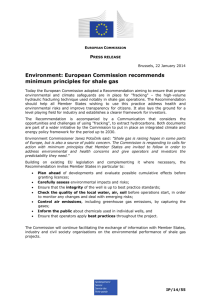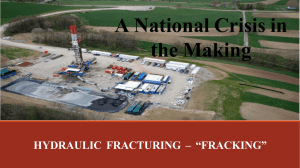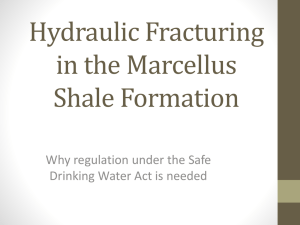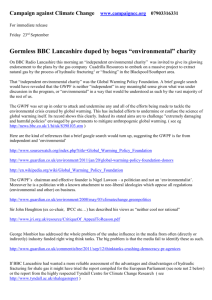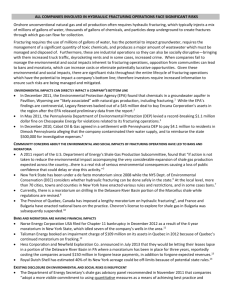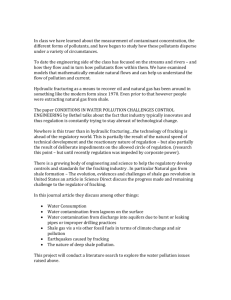EPA*s Energy Extraction Enforcement Initiative ABA SEER Law
advertisement
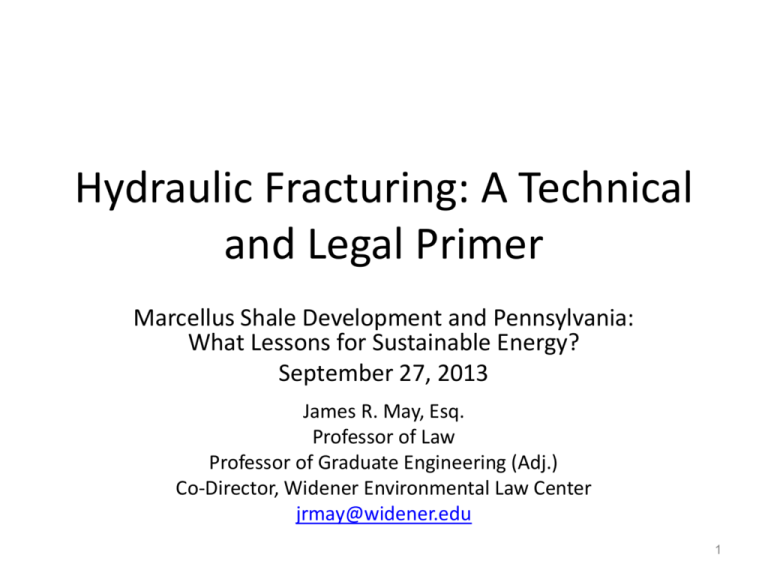
Hydraulic Fracturing: A Technical and Legal Primer Marcellus Shale Development and Pennsylvania: What Lessons for Sustainable Energy? September 27, 2013 James R. May, Esq. Professor of Law Professor of Graduate Engineering (Adj.) Co-Director, Widener Environmental Law Center jrmay@widener.edu 1 We must develop our domestic resources safely, responsibly, and efficiently. President Barack Obama, Blueprint for a Secure Energy Future, March 30, 2011 Presentation Outline • Hydraulic Fracturing in a nutshell • Federal Regulation of HF – Federal legislation – EPA Activities • State, Local and Global Regulation of HF • Emerging Legal Issues in HF 4 Hydraulic Fracturing in a Nutshell • • • • • • How shale gas forms Description of “hydraulic fracturing” History Process Potential production and reserves Some environmental impacts 5 How Does Shale Gas Form? • Fossil fuels are the product of the decomposition of carbonbased life forms, called organic matter, e.g., plants and animals. • Due to decomposition, pressure, compaction and core heat, some of this organic matter converts to tight rock formations, known as “shale strata.” • This shale embeds natural gas and petroleum in two types of formations known as “plays”: – Shallow plays within one mile of the surface that embeds “newer” (few million years old) gas produced by biological processes, referred to as “biogenic “ methane gas. – Deep plays 1-8 miles from the surface produced over hundreds of millions of years, covered and compacted millions of times over by other geologic formations (e.g., soil, glaciers, water, etc.) and subjected to thermal conversion by the Earth’s core, referred to as “thermogenic” methane gas. 6 What is “Hydraulic Fracturing?” • “Hydraulic fracturing” is a process that injects large amounts of water under pressure to shatter shale strata and thereby liberate and capture the gas and oil embedded within it. • “Vertical” hydraulic fracturing has been used industrially for 100 years in the United States primarily to reach biogenic deposits contained within shallow shale plays. • “Horizontal” hydraulic fracturing is a newer process used primarily to reach the thermogenic deposits contained in deep shale plays. 7 Hydraulic Fracturing: History • HF was first tested in 1903 and first used commercially in 1948. • Most onshore oil and gas wells undergo some form of HF during their lifetime, usually in the final, least-commercial production phase, if market conditions warrrant. Crumbs. • HF had been applied to one million wells by 1988. • Nowadays, about 35,000 wells per year in the U.S. undergo some sort of HF. Natural Gas Extraction: Expansion 10 HF: Potential Reserves and Yield • Department of Energy Estimates: – 1,750 Tcf technically recoverable – 250 Tcf in proved reserves • DOE: Shale/tight sandstone gas & CBM could account for 60.0% of onshore natural gas reserves • NGA: Fracking adds 30% to estimated recoverable hydrocarbon reserves in the U.S. • EPA: Marcellus Shale area – roughly size of Greece – estimated to contain more than 500 Tcf of natural gas. HF: Processs Generally, three basic steps – “The Pad”: Inject hydraulic fluid, without proppant, into target formation • Pumped at about 100 bbl/minute; Pressure: around 14,000 psi • Pressure tests conducted to check for leakage into neighboring formations – Add “proppant” • Proppant—sand, ceramics, wire mesh, sintered bauxite • Proppant carried into fractures—designed to hold the fractures open for flow – Flush the reservoir • 20-50% return—although anecdotal data from industry says 80% or more – Produce the gas normally thereafter. Productive for 1-2 years. Geometric decline over time. – Total amount of fracking fluid use per well in the Marcellus: 1-5 million gallons HF Fluid Composition Generally, fracking fluid is composed of: – Water—95% or more – Proppant—typically sand, ceramic beads, wire mesh – Surfactant (promotes flow into/out of the formation) • 12-20 different chemicals per site • More than 1,000 overall, including chemicals that are irritants and probably or potentially carcinogenic, teratogenic, mutagenic, or otherwise toxic Overview of Hydraulic Fracturing: Water Use Adverse Environmental Effects 15 Some Causes of Environmental Effects • Construction/Maintenance: – Road construction – Soil Compaction – Habitat destruction by construction and footprint – Air pollution • Operation: – Casing or piping failures – Groundwater contamination, including drinking water – Surface water discharges – Gas leaks – Gas migration – Air pollution & Flaring • Flooding (next slide) • Distribution (pipeline) – – – – – – Compaction Rights of Way disturbance Habitat fragmentation Edge effects Gas leaks Traffic/road wear And, of course, using the gas as a commercial or industrial product 16 Frack Flooding? From Drill Colorado Last Friday: 17 Federal Law and HF • National Environmental Policy Act (requires environmental studies for major activities) • Clean Water Act (requires permit for discharges) • Safe Drinking Water Act (contaminant levels and standards to protect drinking water aquifers) • Emergency Planning and Community Right to Know Act (requires disclosure of releases and location of toxic chemicals) • Resource Conservation and Recovery Act (manages hazardous wastes) • Comprehensive Environmental Response, Compensation and Liability Act (responds to releases of hazardous substances) • Clean Air Act (permits/controls on toxic and methane emissions) • Toxic Substances Control Act (requires study and registration of significant new uses of chemicals) • FRAC ACT of 201X 18 As applied to HF: Section 390 of the Energy Policy Act of 2005: Certain Oil and Gas Drilling Activities are “subject to a rebuttable presumption that the use of a categorical exclusion under the National Environmental Policy Act of 1969 would apply if the activity is conducted pursuant to the Mineral Leasing for the purpose of exploration or development of oil or gas…” (No Environmental Impact Assessment) National Environmental Policy Act Ordinarily: Requires completion of an “Environmental Impact Statement” for “major federal actions significantly affecting the quality of the human environment,” based upon preparation of an “environmental assessment” Clean Water Act Ordinarily: Prohibits discharges of pollutants without a permit. As Applied to HF: Injection: The term “pollutant” does not include: “water, gas, or other material which is injected into a well to facilitate production of oil or gas, or water derived in association with oil or gas production and disposed of in a well, if the well-used either to facilitate production or for disposal purposes is approved by authority of the State in which the well is located, and if such State determines that such injection or disposal will not result in the degradation of ground or surface water resources.”(States routinely make such determinations) Direct Discharges into Surface Waters: Zero discharge standard Indirect Discharges (stormwater runoff, erosion, etc.): Exempts most oil and gas field activities Applied to HF: EPA refused to apply to HF, until ordered to do so: “EPA's argument that a methane gas production well is not an "injection well" because it is used primarily for gas extraction is spurious…In view of clear statutory language requiring the regulation of all such activities, they must be regulated, regardless of the other uses of the well in which these activities occur.” Leaf v. EPA (1997). Safe Drinking Water Act Ordinarily: The SDWA contains a program designed to protect underground sources of drinking water (USDW) from contamination from underground injection, known as the “Underground Injection Control Program” (UIC). 2. Both injection of diesel fuels during hydraulic fracturing and injection of flowback and/or produced water is subject to UIC permitting requirements – mostly by “primacy” States 3. In May 2012 EPA issued draft permitting guidance for EPA permit writers addressing oil and gas hydraulic fracturing using diesel fuels. Comment period closed August 2012. Safe Drinking Water Act More recently … 1. In 2005, Congress enacted the National Energy Policy Act to revise the definition of “underground injection” to exclude “the underground injection of fluids or propping agents (other than diesel fuels) pursuant to hydraulic fracturing operations related to oil, gas, or geothermal production activities.” (Halliburton loophole) Emergency Planning and Community Right-to-Know Act Ordinarily: 1. Requires companies to report releases of chemicals under ground, onto land, or into water or air for publicly available inventory; and, 2. Requires companies to maintain information on location, types and amounts for hazardous chemicals for use by emergency personnel As applied to HF: Exempts releases from HF and other O & G operations As applied to HF: -HF Fluid is considered to be a “Federally Permitted Releases”: “any injection of fluids or other materials authorized under applicable State law (i) for the purpose of stimulating or treating wells for the production of crude oil, natural gas, or water, (ii) for the purpose of secondary, tertiary, or other enhanced recovery of crude oil or natural gas, or (iii) which are brought to the surface in conjunction with the production of crude oil or natural gas and which are reinjected.” Comprehensive Environmental Response, Compensation, and Liability Act Ordinarily: -CERCLA requires removal and clean up of sites contaminated by hazardous substances. -CERCLA requires that reporting of “releases” of hazardous substances, including into ground. -HF fluid is a hazardous substance. As applied to HF: • Pursuant to congressional instruction in 1988, EPA determined that HF and other O & G injection fluids do not warrant regulation as hazardous wastes. Resource Conservation and Recovery Act Ordinarily: • Producers must make sure hazardous wastes are treated, stored and disposed properly. • Transporters must follow DOT labeling and route requirements • Owner/operators of treatment, storage and disposal facilities must obtain a permit and comply with technology and performance standards As applied to HF: 1. NSPS for Oil and Gas Production Industry, promulgated April 2012. Identified unregulated sources of emissions: –Well completions (and re-completions) --Pneumatic controllers --Storage vessels (condensate and crude oil tanks) 2. Sets NSPS for Well Completions (and re-completions), but allows combustion “flaring” for certain wells (wildcat, delineation, and low pressure wells) and for portion of flowback emissions where green completion is not feasible. 3. MACT not set for HF facilities. 4. States can still regulate, but usually don’t. Clean Air Act Ordinarily: 1. Requires “New Source Performance Standards” for new stationary source emitters 2. Requires permit and use of “Maximum Achievable Control Technology” (MACT) for mid- to large-size sources As applied too HF: 1. EPA (and CDC) have not applied TSCA to HF or chemical constituents. 2. In August 2011, Earthjustice and others petitioned EPA to use TSCA to issue rules requiring makers of chemicals used in oil and gas production to provide information to EPA on the health effects of these chemicals. 3. In November 2011, EPA notified the petitioners that it is partially granting the petition and will initiate a rulemaking process to obtain data on chemical substances used in HF to complement state well-bywell disclosure programs. 4. No rule or proposed rule as of yet. Toxic Substances Control Act Ordinarily: Requires registration of certain toxic chemicals and/or processes or practices. Process usually commences with a call for information and studies about the health impacts of exposure. CONGRESSIONAL DEVELOPMENTS: “FRAC” ACT OF 2009, 2010, 2011, 2012 “A bill to amend the Safe Drinking Water Act to repeal a certain exemption for hydraulic fracturing, and for other purposes.” • Requires disclosure of chemical composition of “Frac Fluids” •Not Enacted Federal Action: EPA 1. Study of Potential Impacts of HF 2. Requests for Voluntary Disclosure of Information 29 Nov. 2011: EPA Plan of Study on Drinking Water Impacts of HF Questions To Be Addressed by EPA HF/Water Study • Water acquisition: What are the possible impacts of large volume water withdrawals from ground and surface waters on drinking water resources? • Chemical mixing: What are the possible impacts of hydraulic fracturing fluid surface spills on or near well pads on drinking water resources? • Well injection: What are the possible impacts of the injection and fracturing process on drinking water resources? • Flowback and produced water: What are the possible impacts of flowback and produced water (collectively referred to as “hydraulic fracturing wastewater”) surface spills on ornear well pads on drinking water resources? • Wastewater treatment and waste disposal: What are the possible impacts of inadequate treatment of hydraulic fracturing wastewater on drinking water resources? 31 December 2012: Study of the Potential Impacts of Hydraulic Fracturing on Drinking Water Resources PROGRESS REPORT U.S. Environmental Protection Agency Office of Research and Development Bernadette Rappold, Director Special Litigation and Projects Division Rappold.Bernadette@epa.gov EPA HF/ Water Progress Report: • Information from 9 Companies • Reviewed well construction records for 333 wells • 24,925 wells between September 2009 and October 2010 • More than 12,000 well records from FracFocus • More than 1,000 unique chemical substances 33 EPA HF/Water Study: Next Steps • • • • • • Issue “Draft Report” in 2014 Public Comments by ?? Peer Review by ?? Final Report by ?? Rules by ?? And so on … 34 Other EPA Action • In 2009, EPA Issues Voluntary Information Requests to Nine Hydraulic Fracturing Companies Requesting Detailed Information About the Chemical Composition of Fracking Fluids, known as “Halliburton Request” – Among chemicals disclosed are materials found in cleaners, car wax, and paint thinner. – Typical Response: “Additives used in hydraulic fracturing fluids include a number of compounds found in common consumer products…” • Request for Peer-Reviewed Information (Nov. 9, 2012) 35 State (not PA), Local and Global Developments 36 State Actions • Most state and local actions involve Marcellus Shale • Some are Legislative; others constitutional; others hybrids • Many are from PA and NY • Promote: Tx, WV, Ohio • Ban: Vermont 37 Emerging State Law Provisions • Express inclusion HF into laws & regulations • Requirement that logs and pressure test results are included in disclosures to state authorities • Disclosure of HF fluids, proppants and ratios • Specific disposal regimens for HF fluid, focusing on the protection of existing surface- and groundwater assets. • Replacement/remediation of contaminated water assets. • Minimum depths of HF—not close to the surface • Stringent Casing Standards (next slide) • Bonding • Insurance Casing Standards • Pennsylvania as an example. 25 Pa. Code chap. 78 • Numerical performance standard for inside casing gas pressure. Section 78.73(c). • Casing design standards. Sections 78.81-87. New York • Statewide moritorium pending development of rules • NY-DEC strict regulation all but banning in Skaneateles Lake and Finger Lakes regions of Catskills • County Bans: – Onondago – Tomkins – Cortland • City Bans: Syracuse, Lake, Tully, Elbridge, DeWitt, Enfield, Ithaca, Danby and Ulysses 40 Other State Developments • Statewide Bans! (e.g., Vermont) • Statewide Backlash! North Carolina returns $580,000 federal grant to study impact of fracturing on surface and groundwater and wetlands. (Tues., Sept. 24, 2013). 41 Emerging Local Regulations Certain fracking matters have been considered at the county/city level – Bans (Berks & Montgomery Counties) – Noise control – Traffic control – Other measures • • • • Hours of operations (daylight or hour-based) (Santa Fe County, NM) Restrictions on contents of the fracing fluid (Santa Fe County, NM) Logs to be kept and turned into county authorities (Lovington, NM) Pressure test failures must be reported to city (Lovington, NM) Global Developments: Embracing HF • Poland (thought to have among the largest resident reserves of shale oil gas). • Denmark (commissioned most of its shale gas reserves for development). • China (estimated to have fifty percent more shale gas reserves than the United States) • The United Kingdom (recently given the green light to HF shale gas). 43 Global Developments: Prohibiting • France (This is despite some predictions of possible fossil fuel resources of up to 100 million cubic meters of shale oil in the Paris basin and five billion cubic meters of shale gas in a bed across the south of France.) • Bulgaria (forbidding Chevron from using fracking to search of large seams of embedded natural gas) • At Subnational level: – – – – New South Wales (Australia) Victoria (Australia) Quebec (Canada) Karoo (ZA 44 Global Developments: Highly Regulated or Restricted • Chemical-free (Ireland, New Zealand) • Non-hydraulic (Mexico granted a permit to the U.S. Chimera Energy Corporation to deploy its new non-hydraulic shale oil extraction technology in Mexico’s Chicontepec Basin, considered Mexico's largest certified hydrocarbon reserve, totaling more than 139 billion barrels of oil equivalent. 45 Emerging Legal Issues 46 Constitutional Issues • Whether states may preempt local actions to prohibit fracturing? E.g., Robinson et al. v. Commonwealth of Pennsylvania • Whether states may require that gas produced from fracturing be sold in-state? • Whether states may prohibit shale gas produced in-state from entering global markets? • Whether, and for what, Congress may get involved? • What degree of regulation constitutes a compensable taking? 47 Constitutional Questions?: Principles of Constitutional Environmental Law Emerging Property and Tort Law Issues • • • • • • Application of the rule of Capture Riparian and Rights to Water Nuisance Trespass Negligence Strict Liability for Abnormally Dangerous Activities 49 Emerging Corporate Law Issues: Forfeiture of Corporate Charters? • Section 284(a) of the Delaware General Corporation Law gives the Delaware Attorney General power to seek forfeiture of corporate charters “for abuse, misuse of nonuse of [ ] corporate powers.” • As open-ended as Section 274(a) sounds, State of Delaware has not used as a roving means of policing noncompliance with regulatory laws (federal or state), or curbing behavior not otherwise prohibited. 50 Sunrise or Sunset for DSHF? 51 Questions?
